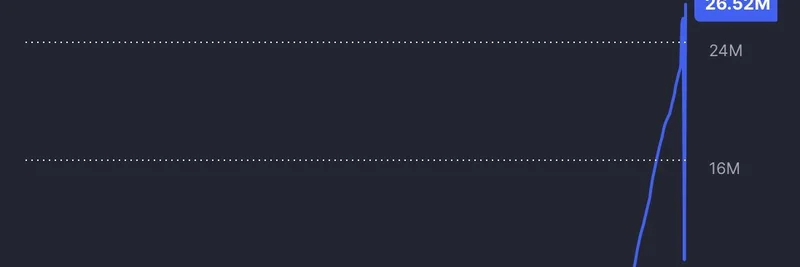Hey crypto fans! Let's take a closer look at a potentially spicy meme coin popping up on the Solana blockchain called Kimchi. If you're deep in the world of meme tokens, you know Solana is a hot spot thanks to its speed and low fees, making it super easy and cheap to launch and trade new tokens.
This report dives into the Kimchi token, specifically the one with the address PoV962CBnMWDDT1wwPLueLbLCJxGVCv3PW6c4aepump on the Solana network. While the name "Kimchi" might appear elsewhere (sometimes even linked to Ethereum), the address confirms we're focusing on the Solana version here.
What is the Kimchi Token on Solana?
Kimchi ($KIMCHI$) is a meme coin that launched on the Solana blockchain back on September 26, 2024. Its origin story is pretty classic meme coin stuff – it's described as coming from a merger of "Pickle" and "Fluffy Pickle" to create "one spicy pickle." This playful branding is typical of meme coins that often leverage internet jokes or cultural references.
It primarily trades on decentralized exchanges (DEXs) within the Solana ecosystem, with the $KIMCHI$/SOL pair being a common spot for activity. Like many meme coins, Kimchi doesn't seem to have an official website or a detailed whitepaper, which can make it a bit tricky to figure out the team's long-term plans or any potential utility beyond being a tradable asset.
Token Details and Supply
Based on available data, here are some specifics about the Kimchi token on Solana:
- Token Symbol: KIMCHI
- Token Address (Solana):
PoV962CBnMWDDT1wwPLueLbLCJxGVCv3PW6c4aepump - Total Supply: 690,000,000 KIMCHI tokens
- Circulating Supply: It appears the entire 690,000,000 tokens are in circulation, meaning there aren't reported locked tokens or specific reserve allocations.
The tokenomics are straightforward, which is common for meme coins focused purely on trading. There's no info available about things like staking, token burns, or future emissions, suggesting the supply is static for now unless the community or unknown developers initiate changes later. The lack of detail on initial distribution also means we don't have clear visibility into who holds how much, which is a common concern in the meme coin world.
Market Vitals
Meme coins are known for their wild price swings, and Kimchi is no different. As of late April 2025, its market stats looked something like this:
- Price: Hovering around $0.000011 USD (or roughly 0.0000001213 BTC). Remember, this number bounces around a lot.
- Market Cap: Approximately $31,200 USD. This places it firmly in the micro-cap category, way down the list on sites like CoinGecko.
- Trading Volume: Can be very low, sometimes just a few dozen dollars over 24 hours. However, it can also see sudden spikes driven by speculative buying, like the reported 463.7% surge within 10 minutes on April 28, 2025, though these pumps aren't always sustained.
- Liquidity: There's a liquidity pool, mainly on Raydium, reported to be around $101,171. While this sounds decent for a micro-cap coin, the low daily trading volume suggests that larger trades might still face noticeable price impact (slippage).
Its current price is significantly lower than its all-time high, and only slightly above its all-time low, reflecting the typical volatility and downward trend many micro-cap meme coins experience after the initial hype phase.
Community and Presence
The Kimchi token has some presence online, mainly on platforms like X (formerly Twitter) and Telegram. The community seems small and largely focused on tracking price movements and promoting the token for short-term gains. Posts often highlight price pumps or trading signals rather than discussing project development or broader use cases.
One report mentions an aim to become Korea's leading meme coin, with some community engagement on platforms like Instagram. This might tie into the broader concept of the "Kimchi Premium," which refers to the difference in crypto prices between South Korean exchanges and international ones, influenced by local market dynamics and regulations. However, it's crucial to understand that the Kimchi token itself is not the Kimchi Premium; it's just a token leveraging the name.
There's no sign of a deeply engaged community working on long-term project goals, which is common for tokens launched quickly on platforms like Pump.fun, a platform known for making token creation super easy but sometimes resulting in less sustainable projects.
Risks and What to Watch Out For
Investing in meme coins like Kimchi on Solana is inherently risky. Here are some major points to consider:
- High Volatility: Prices can skyrocket or crash in minutes. This is driven purely by speculation and sentiment, not underlying value.
- Lack of Utility: Kimchi has no stated use case beyond being traded. Its value depends solely on hype and the ability to attract new buyers.
- Transparency Issues: No official website, whitepaper, security audits, or known development team (KYC verification missing) are major red flags.
- "Rug Pull" Potential: The lack of transparency and developer accountability raises concerns that insiders or developers could sell their holdings and abandon the project, causing the price to collapse. Some community warnings already point to this risk.
- Competition: The Solana meme coin space is incredibly crowded with established players like Bonk and Dogwifhat dominating attention and liquidity. Kimchi faces an uphill battle for sustained visibility.
- Regulatory Uncertainty: The regulatory landscape for tokens on platforms like Solana is still evolving. The U.S. Securities and Exchange Commission (SEC) has indicated that certain Solana tokens might be considered securities, which could lead to stricter regulations or delistings from exchanges.
How to Track and Trade Kimchi (If You Choose To)
If you're interested in keeping an eye on Kimchi or trading it despite the risks, you'll typically need:
- A Solana-compatible wallet (like Phantom or Solflare).
- Some SOL tokens in your wallet to cover transaction fees and trade for KIMCHI.
- Access to a Solana DEX like Raydium or Orca.
For more advanced tracking and analysis of Kimchi and other meme coins on Solana, platforms like GMGN.AI can be useful. GMGN.AI is designed for tracking meme tokens across various chains, offering features like smart money tracking, real-time analytics, and security checks to help identify potential risks like honeypots before trading. You can specifically check out Kimchi's page on GMGN.AI here. Just be aware that such platforms may have their own fees (GMGN.AI mentions a 1% transaction fee).
Conclusion
The Kimchi token ($KIMCHI$, address PoV962CBnMWDDT1wwPLueLbLCJxGVCv3PW6c4aepump) is a classic example of a speculative meme coin on the Solana blockchain. It benefits from Solana's efficient network but carries the significant risks typical of micro-cap meme tokens: extreme volatility, lack of transparency, potential for scams, and heavy reliance on fleeting online hype.
While Solana's growing ecosystem and the general popularity of meme coins in a bullish market could offer brief moments of opportunity for traders, Kimchi's lack of utility, audits, and a clear development path make it a highly speculative asset.
For anyone considering interacting with Kimchi: Proceed with extreme caution. Only use funds you can afford to lose. Conduct your own thorough research (due diligence!) and consider using tools like GMGN.AI for real-time data and risk checks if you plan to trade. Monitor community sentiment on platforms like X, but be wary of hype-driven signals.
Ultimately, Kimchi on Solana is a high-stakes gamble in the volatile world of meme tokens. Stay informed and stay safe!


